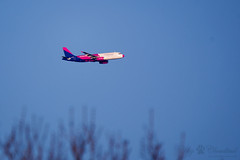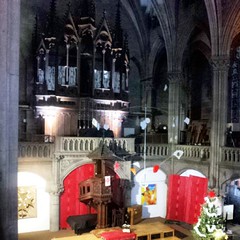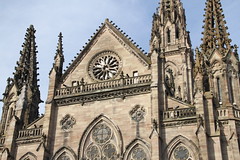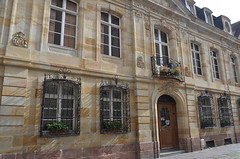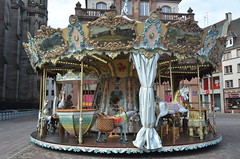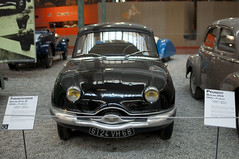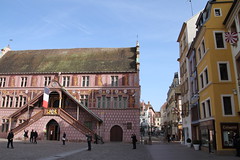Mulhouse
Mulhouse (French: [myluz]; or ; German: [myːlˈhaʊzn̩]; meaning "mill house") is a city of the European Collectivity of Alsace (formerly Haut-Rhin department, in the Grand Est region of France), close to the Swiss and German borders. It is the largest city in Haut-Rhin and second largest in Alsace after Strasbourg.
Mulhouse is famous for its museums, especially the (also known as the , 'National Museum of the Automobile') and the (also known as , 'French Museum of the Railway'), respectively the largest automobile and railway museums in the world. An industrial town nicknamed "the French Manchester", Mulhouse is also the main seat of the Upper Alsace University, where the secretariat of the European Physical Society is found.
History
In 58 BC a battle took place west of Mulhouse and opposed the Roman army of Julius Caesar by a coalition of Germans led by Ariovistus. The first written records of the town date from the twelfth century. It was part of the southern Alsatian county of Sundgau in the Holy Roman Empire. From 1354 to 1515, Mulhouse was part of the Décapole, an association of ten Free Imperial Cities in Alsace. The city joined the Swiss Confederation as an associate in 1515 and was therefore not annexed by France in the Peace of Westphalia in 1648 like the rest of the Sundgau. An enclave in Alsace, it was a free and independent Calvinist republic, known as Stadtrepublik Mülhausen, associated with the Swiss Confederation until, after a vote by its citizens on 4 January 1798, it became a part of France in the Treaty of Mulhouse signed on 28 January 1798, during the Directory period of the French Revolution.
Starting in the middle of the eighteenth century, the Koechlin family pioneered cotton cloth manufacturing; Mulhouse became one of France's leading textile centers in the nineteenth century. André Koechlin (1789–1875) built machinery and started making railroad equipment in 1842. The firm in 1839 already employed 1,800 people. It was one of the six large French locomotive constructors until the merger with Elsässische Maschinenbau-Gesellschaft Grafenstaden in 1872, when the company became Société Alsacienne de Constructions Mécaniques.
After the Prussian victory in the Franco-Prussian War (1870–1871), Mulhouse was annexed to the German Empire as part of the territory of Alsace-Lorraine (1871–1918). The city was briefly occupied by French troops on 8 August 1914 at the start of World War I, but they were forced to withdraw two days later in the Battle of Mulhouse. Alsatians who celebrated the appearance of the French army were left to face German reprisals, with several citizens sentenced to death. After World War I ended in 1918, French troops entered Alsace, and Germany ceded the region to France under the Treaty of Versailles. After the Battle of France in 1940, it was occupied by German forces until its return to French control at the end of World War II in May 1945.
The town's development was stimulated first by the expansion of the textile industry and tanning, and subsequently by chemical and Engineering industries from the mid 18th century. Mulhouse was for a long time called the French Manchester. Consequently, the town has enduring links with Louisiana, from which it imported cotton, and also with the Levant. The town's history also explains why its centre is relatively small.
Geography
Two rivers run through Mulhouse, the Doller and the Ill, both tributaries of the Rhine. Mulhouse is approximately from Strasbourg and Zürich; it is from Milan and about from Frankfurt. It lies close enough to Basel, Switzerland and Freiburg, Germany to share the EuroAirPort international airport with these two cities.
Districts
Medieval Mulhouse consists essentially of a lower and an upper town.
- The lower town was formerly the inner city district of merchants and craftsmen. It developed around the Place de la Réunion (which commemorates its reunion with France). Nowadays this area is pedestrianised.
- The upper town developed from the eighteenth century on. Previously, several monastic orders were established there, notably the Franciscans, Augustinians, Poor Clares and Knights of Malta.
- The Nouveau Quartier (New District) is the best example of urban planning in Mulhouse, and was developed from 1826 on, after the town walls had been torn down (as they were in many towns in France). It is focused around the Place de la République. Its network of streets and its triangular shape are a good demonstration of the town's desire for a planned layout. The planning was undertaken by the architects G. Stolz and Félix Fries. This inner city district was occupied by rich families and the owners of local industries, who tended to be liberal and republican in their opinions.
- The Rebberg district consists of grand houses inspired by the colonnaded residences of Louisiana cotton planters. Originally, this was the town's vineyard (the word Rebe meaning vine in German). The houses here were built as terraces in the English style, a result of the town's close relationship with Manchester, where the sons of industrialists were often sent to study.
Population
The population data in the table and graph below refer to the commune of Mulhouse proper, in its geography at the given years. The commune of Mulhouse absorbed the former commune of Dornach in 1914 and Bourtzwiller in 1947.
Main sights
- Hôtel de Ville (1552). The town hall was built in 1553 in the Rhenish Renaissance style. Montaigne described it as a "palais magnifique et tout doré" ("splendid golden palace") in 1580. It is known for its trompe-l'œil paintings, and its pictures of allegories representing the vices and virtues.
- Workers' quarter (mid 19th century), inspired workers' quarters in many other industrial towns.
- Place de la Bourse and the building of the Société Industrielle de Mulhouse, in the Nouveau Quartier (19th century)
- Cité de l'Automobile (featuring the Schlumpf collection)
- Cité du Train successor to Musée Français du Chemin de Fer (French National Railway Museum)
- Museum of Electricity (Electropolis)
- Musée des Beaux-Arts (Fine Arts Museum)
- Musée historique (History Museum, located in th Hôtel de Ville
- Museum of Printed Textiles (Musée de l'impression sur étoffes)
- The Parc Zoologique et Botanique de Mulhouse (botanical garden and zoo)
- Saint-Steffen Calvinist temple (1859–1869), by Jean-Baptiste Schacre
Principal economic activities
As early as the mid-19th century, Mulhouse was known as "the industrial capital of Alsace", the "city with a hundred chimneys" (cité aux cent cheminées) and "the French Manchester".
- Automobile industry (Peugeot's Mulhouse factory is the largest employer in Alsace)
- Chemical industry (ICMD)
- Electronics (Clemessy)
- Engineering (SACM – Wärtsilä)
Between 1909 and 1914 there was an aircraft manufacturer, Aviatik, in Mulhouse.
Road
Motorway A36 is the main axis connecting the city with the west of the country, to cities such as Dijon, Paris and Lyon. The A35 is the main north–south axis, connecting cities such as Strasbourg and Basel.
People
Mulhouse was the birthplace of:
- Maurice Achener (1881–1963), French illustrator, painter, and print maker
- Jean de Beaugrand (1584–1640), lineographer and mathematician
- (born 1955), composer and synthesist
- Bernard Bloch (born 1949), actor and director
- Samir Bourouina (born 1978), professional footballer
- Jean Brenner (1937–2009), painter
- Karl Brandt (1904–1948), German Nazi personal physician to Adolf Hitler and head administrator of the T-4 Euthanasia Program, executed for war crimes
- David Cage (born 1969), French video game designer, writer and musician. Born in Mulhouse, Cage was the first game developer to receive the Legion of Honour, the highest decoration granted in France.
- Pierre Chambon (born 1931), biologist
- Cléopatre Darleux (born 1989), handball goalkeeper
- Mireille Delunsch (born 1962), soprano
- Tom Dillmann (born 1989), racing driver
- Artur Dinter (1876–1948), writer and Nazi politician
- Dorian Diring (born 1992), footballer
- Adrien Dollfus (1858–1921), French zoologist and carcinologist
- Jean Dollfus (1800–1887), French industrialist
- Jean Dorst (1924–2001), ornithologist
- Alfred Dreyfus (1859–1935), French military officer best known for being the focus of the Dreyfus affair
- Huguette Dreyfus (1928–2016), harpsichordist
- Léon Ehrhart (1854–1875), composer
- Yann Ehrlacher (born 1996), racing driver
- Nusch Éluard (1906–1946), performer, model and surrealist artist
- François Florent (born François Eichholtzer, 1937), actor, founder of the Cours Florent
- Georges Friedel (1865–1933), mineralogist, son of Charles Friedel
- Charles Frédéric Girard (1822–1895), biologist specializing on ichthyology and herpetology
- Jean-Gaspard Heilmann (1718–1760), painter
- (1822–1859), photographer
- (1898–1964), diplomat
- Daniel Jelensperger (1799–1831), musicologist
- Katia and Maurice Krafft, volcanologists
- Johann Heinrich Lambert (1728–1777), mathematician, physicist and astronomer
- Joffrey Lauvergne (born 1991), basketball player
- Friedrich Wilhelm Levi (1888–1966), mathematician
- François Loeser (born 1958), mathematician
- Paul Meyer (born 1965), clarinetist
- Hervé Milazzo (born 1975), professional footballer
- Véronique North-Minca (born 1953), diplomat
- Thierry Omeyer (born 1976), handball goalkeeper
- Marc Pfertzel (born 1981), football player
- Rémy Pflimlin (1954–2016), CEO of France Télévisions from 2010 to 2015
- Pierre Probst (1913–2007), comic and children book artist
- Napoléon Henri Reber (1807–1880), composer
- Claire Roman (1906–1941), French Air Force pilot in World War II
- Daniel Roth (born 1942), organist, composer and pedagogue
- Franz Eugen Schlachter (1859–1911), revivalist preacher, classical scholar, and translator of the Schlachter Bible
- Christiane Scrivener (born 1925), EU-Commissioner
- Daniel Schlumberger (1904–1972), archaeologist and professor of Near Eastern Archaeology at the University of Strasbourg and later Princeton University
- (born 1953), writer
- Jean Schlumberger (1907–1987), jewelry designer at Tiffany & Co
- René Schützenberger (1860–1916), painter
- Jules Siegfried born Mulhouse in 1837, indus…
Looking for places related to Mulhouse?
Those are other destinations to find places related to Mulhouse:



